Infectious Disease Report: Microbes, Prevention, and Immunity
VerifiedAdded on 2023/01/16
|19
|3419
|39
Report
AI Summary
This report delves into the realm of infectious diseases, beginning with an introduction that defines them as illnesses caused by harmful agents invading a host. It explores the diverse range of microorganisms responsible, including bacteria, viruses, fungi, and protozoa, and examines their mechanisms of causing disease and transmission, with particular emphasis on vector-borne diseases. The report then discusses the routes of entry for pathogens and the body's nonspecific defense systems, such as skin barriers and antimicrobial proteins, as well as the importance of hygiene control in preventing infections. Furthermore, it elucidates the specific immune responses of humoral and cell-mediated immunity, highlighting how these systems contribute to acquired immunity. The report concludes by examining the use of antimicrobial drugs in disease prevention and the mechanisms of drug resistance, providing a comprehensive overview of infectious diseases and the strategies used to combat them.
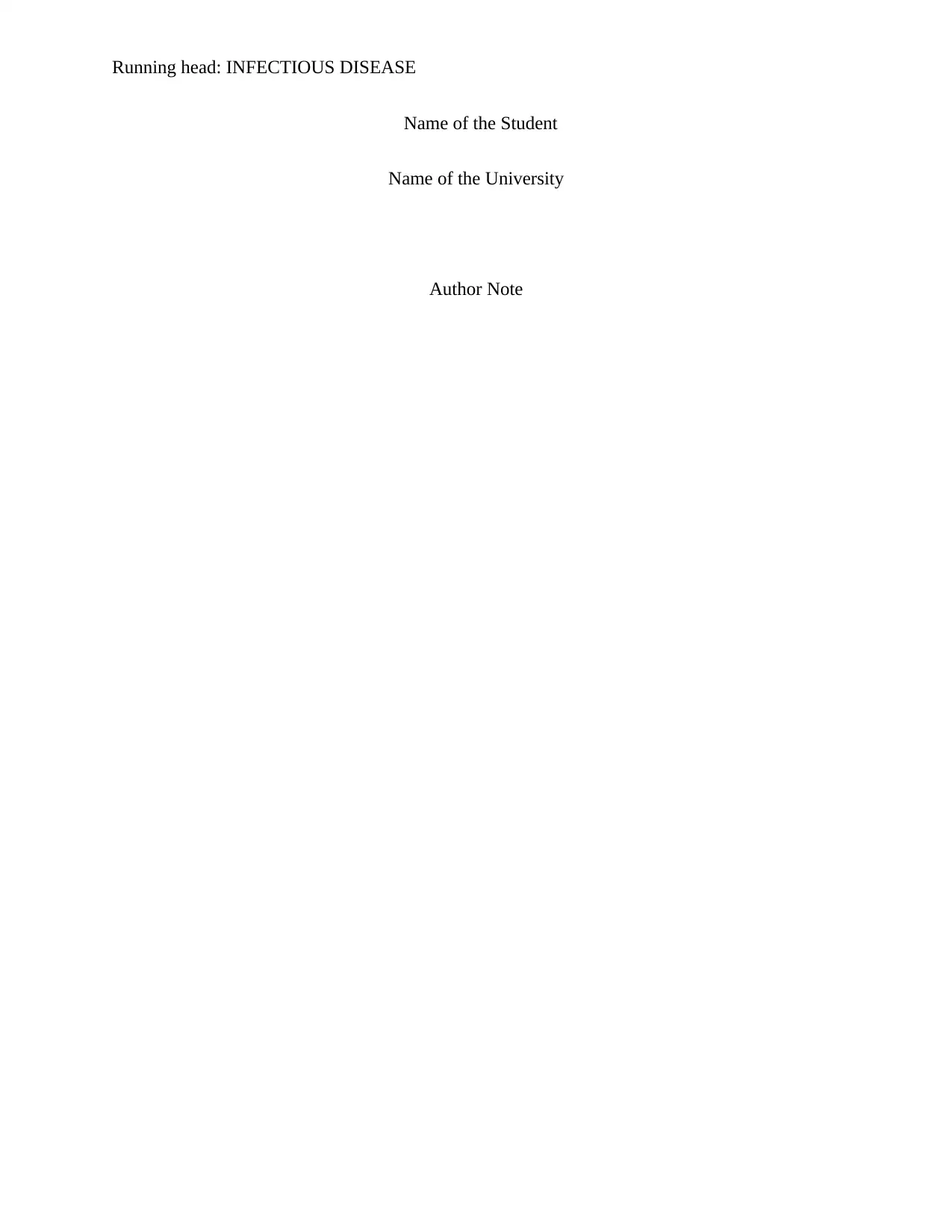
Running head: INFECTIOUS DISEASE
Name of the Student
Name of the University
Author Note
Name of the Student
Name of the University
Author Note
Paraphrase This Document
Need a fresh take? Get an instant paraphrase of this document with our AI Paraphraser
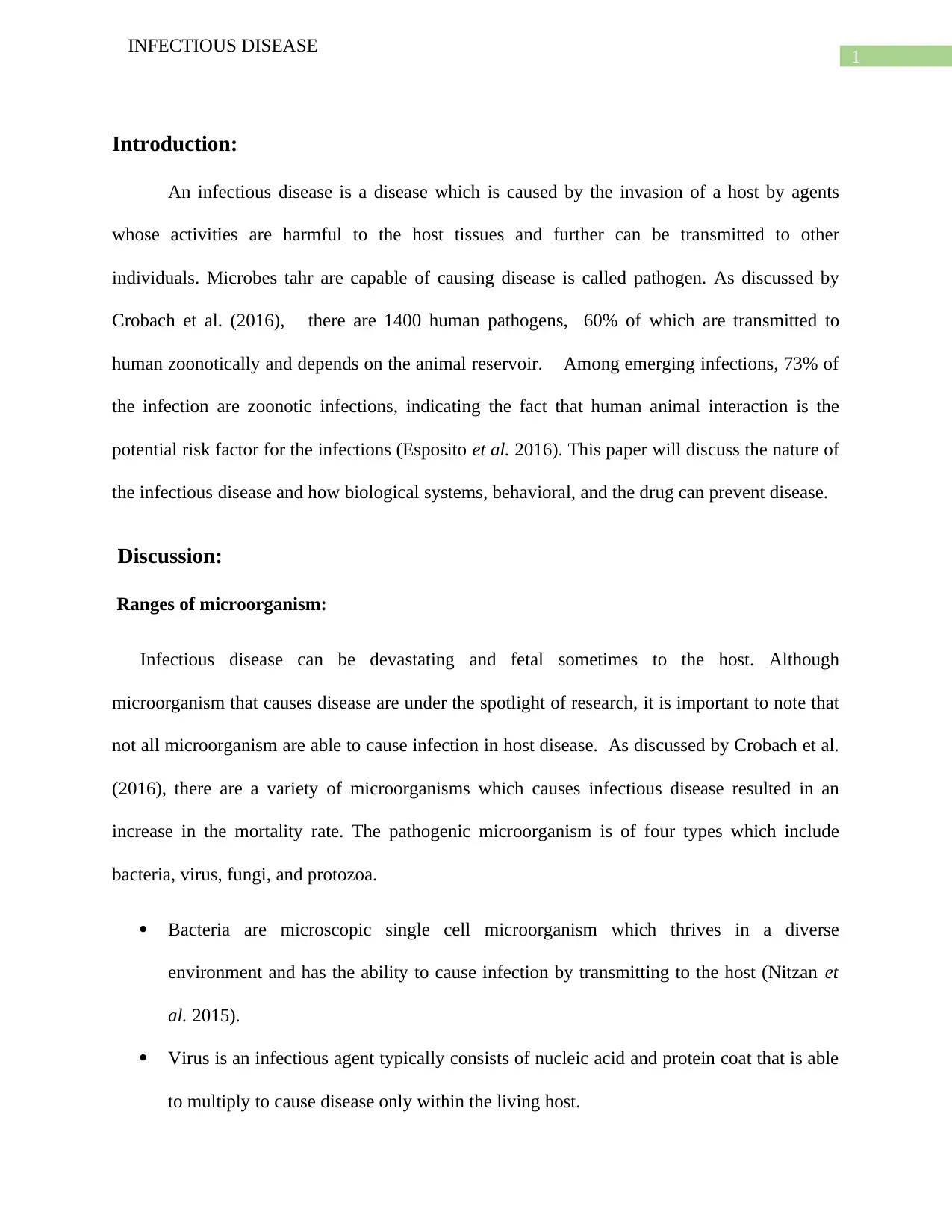
1
INFECTIOUS DISEASE
Introduction:
An infectious disease is a disease which is caused by the invasion of a host by agents
whose activities are harmful to the host tissues and further can be transmitted to other
individuals. Microbes tahr are capable of causing disease is called pathogen. As discussed by
Crobach et al. (2016), there are 1400 human pathogens, 60% of which are transmitted to
human zoonotically and depends on the animal reservoir. Among emerging infections, 73% of
the infection are zoonotic infections, indicating the fact that human animal interaction is the
potential risk factor for the infections (Esposito et al. 2016). This paper will discuss the nature of
the infectious disease and how biological systems, behavioral, and the drug can prevent disease.
Discussion:
Ranges of microorganism:
Infectious disease can be devastating and fetal sometimes to the host. Although
microorganism that causes disease are under the spotlight of research, it is important to note that
not all microorganism are able to cause infection in host disease. As discussed by Crobach et al.
(2016), there are a variety of microorganisms which causes infectious disease resulted in an
increase in the mortality rate. The pathogenic microorganism is of four types which include
bacteria, virus, fungi, and protozoa.
Bacteria are microscopic single cell microorganism which thrives in a diverse
environment and has the ability to cause infection by transmitting to the host (Nitzan et
al. 2015).
Virus is an infectious agent typically consists of nucleic acid and protein coat that is able
to multiply to cause disease only within the living host.
INFECTIOUS DISEASE
Introduction:
An infectious disease is a disease which is caused by the invasion of a host by agents
whose activities are harmful to the host tissues and further can be transmitted to other
individuals. Microbes tahr are capable of causing disease is called pathogen. As discussed by
Crobach et al. (2016), there are 1400 human pathogens, 60% of which are transmitted to
human zoonotically and depends on the animal reservoir. Among emerging infections, 73% of
the infection are zoonotic infections, indicating the fact that human animal interaction is the
potential risk factor for the infections (Esposito et al. 2016). This paper will discuss the nature of
the infectious disease and how biological systems, behavioral, and the drug can prevent disease.
Discussion:
Ranges of microorganism:
Infectious disease can be devastating and fetal sometimes to the host. Although
microorganism that causes disease are under the spotlight of research, it is important to note that
not all microorganism are able to cause infection in host disease. As discussed by Crobach et al.
(2016), there are a variety of microorganisms which causes infectious disease resulted in an
increase in the mortality rate. The pathogenic microorganism is of four types which include
bacteria, virus, fungi, and protozoa.
Bacteria are microscopic single cell microorganism which thrives in a diverse
environment and has the ability to cause infection by transmitting to the host (Nitzan et
al. 2015).
Virus is an infectious agent typically consists of nucleic acid and protein coat that is able
to multiply to cause disease only within the living host.
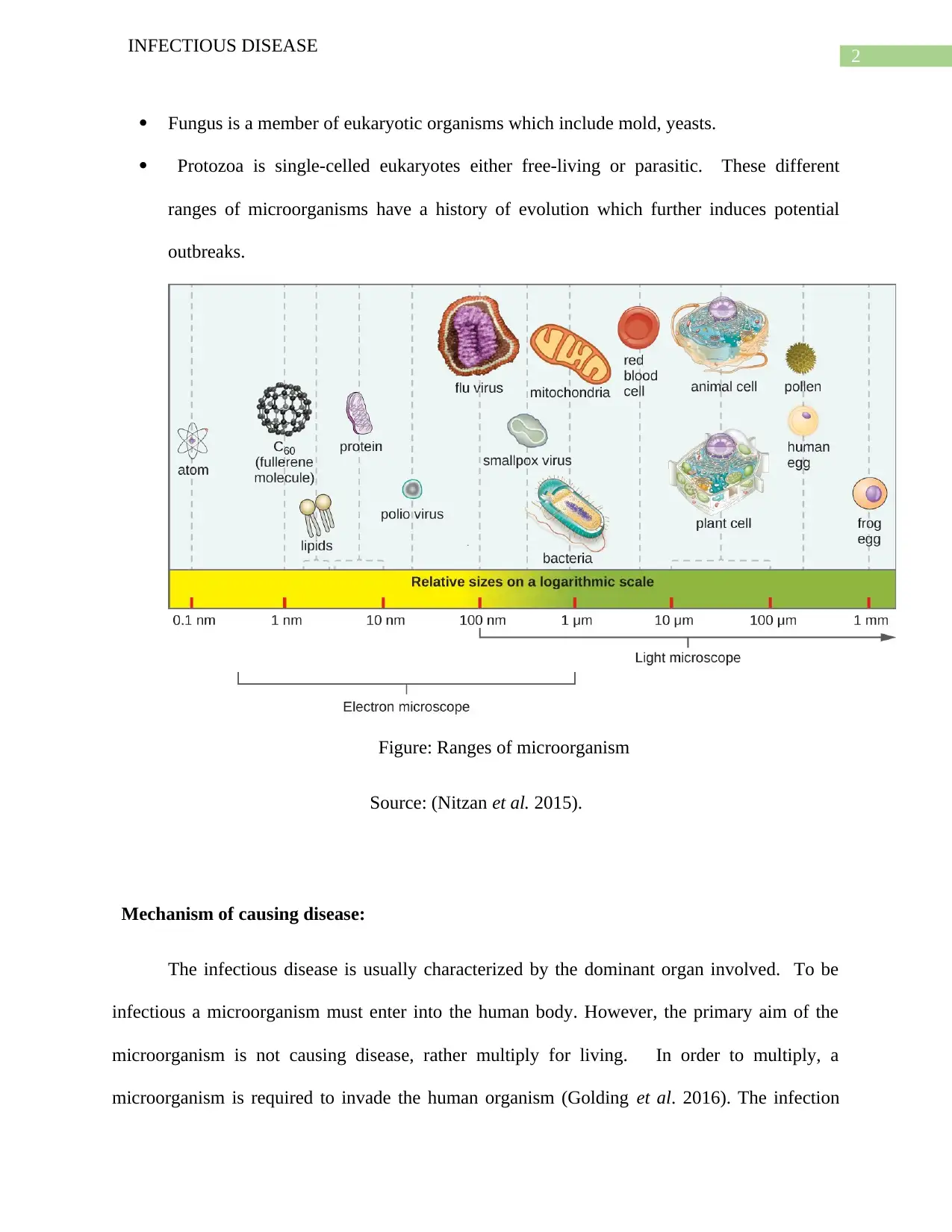
2
INFECTIOUS DISEASE
Fungus is a member of eukaryotic organisms which include mold, yeasts.
Protozoa is single-celled eukaryotes either free-living or parasitic. These different
ranges of microorganisms have a history of evolution which further induces potential
outbreaks.
Figure: Ranges of microorganism
Source: (Nitzan et al. 2015).
Mechanism of causing disease:
The infectious disease is usually characterized by the dominant organ involved. To be
infectious a microorganism must enter into the human body. However, the primary aim of the
microorganism is not causing disease, rather multiply for living. In order to multiply, a
microorganism is required to invade the human organism (Golding et al. 2016). The infection
INFECTIOUS DISEASE
Fungus is a member of eukaryotic organisms which include mold, yeasts.
Protozoa is single-celled eukaryotes either free-living or parasitic. These different
ranges of microorganisms have a history of evolution which further induces potential
outbreaks.
Figure: Ranges of microorganism
Source: (Nitzan et al. 2015).
Mechanism of causing disease:
The infectious disease is usually characterized by the dominant organ involved. To be
infectious a microorganism must enter into the human body. However, the primary aim of the
microorganism is not causing disease, rather multiply for living. In order to multiply, a
microorganism is required to invade the human organism (Golding et al. 2016). The infection
⊘ This is a preview!⊘
Do you want full access?
Subscribe today to unlock all pages.

Trusted by 1+ million students worldwide
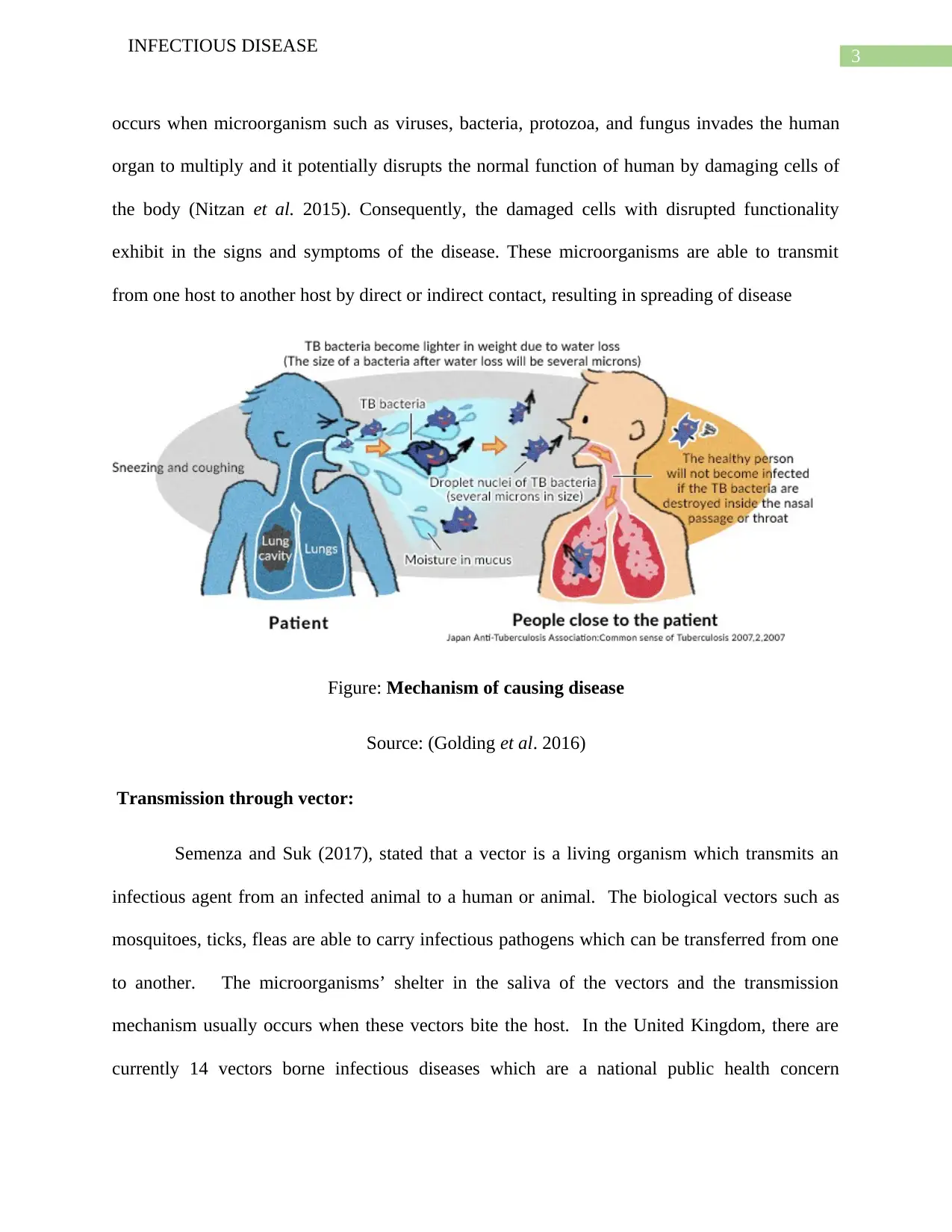
3
INFECTIOUS DISEASE
occurs when microorganism such as viruses, bacteria, protozoa, and fungus invades the human
organ to multiply and it potentially disrupts the normal function of human by damaging cells of
the body (Nitzan et al. 2015). Consequently, the damaged cells with disrupted functionality
exhibit in the signs and symptoms of the disease. These microorganisms are able to transmit
from one host to another host by direct or indirect contact, resulting in spreading of disease
Figure: Mechanism of causing disease
Source: (Golding et al. 2016)
Transmission through vector:
Semenza and Suk (2017), stated that a vector is a living organism which transmits an
infectious agent from an infected animal to a human or animal. The biological vectors such as
mosquitoes, ticks, fleas are able to carry infectious pathogens which can be transferred from one
to another. The microorganisms’ shelter in the saliva of the vectors and the transmission
mechanism usually occurs when these vectors bite the host. In the United Kingdom, there are
currently 14 vectors borne infectious diseases which are a national public health concern
INFECTIOUS DISEASE
occurs when microorganism such as viruses, bacteria, protozoa, and fungus invades the human
organ to multiply and it potentially disrupts the normal function of human by damaging cells of
the body (Nitzan et al. 2015). Consequently, the damaged cells with disrupted functionality
exhibit in the signs and symptoms of the disease. These microorganisms are able to transmit
from one host to another host by direct or indirect contact, resulting in spreading of disease
Figure: Mechanism of causing disease
Source: (Golding et al. 2016)
Transmission through vector:
Semenza and Suk (2017), stated that a vector is a living organism which transmits an
infectious agent from an infected animal to a human or animal. The biological vectors such as
mosquitoes, ticks, fleas are able to carry infectious pathogens which can be transferred from one
to another. The microorganisms’ shelter in the saliva of the vectors and the transmission
mechanism usually occurs when these vectors bite the host. In the United Kingdom, there are
currently 14 vectors borne infectious diseases which are a national public health concern
Paraphrase This Document
Need a fresh take? Get an instant paraphrase of this document with our AI Paraphraser
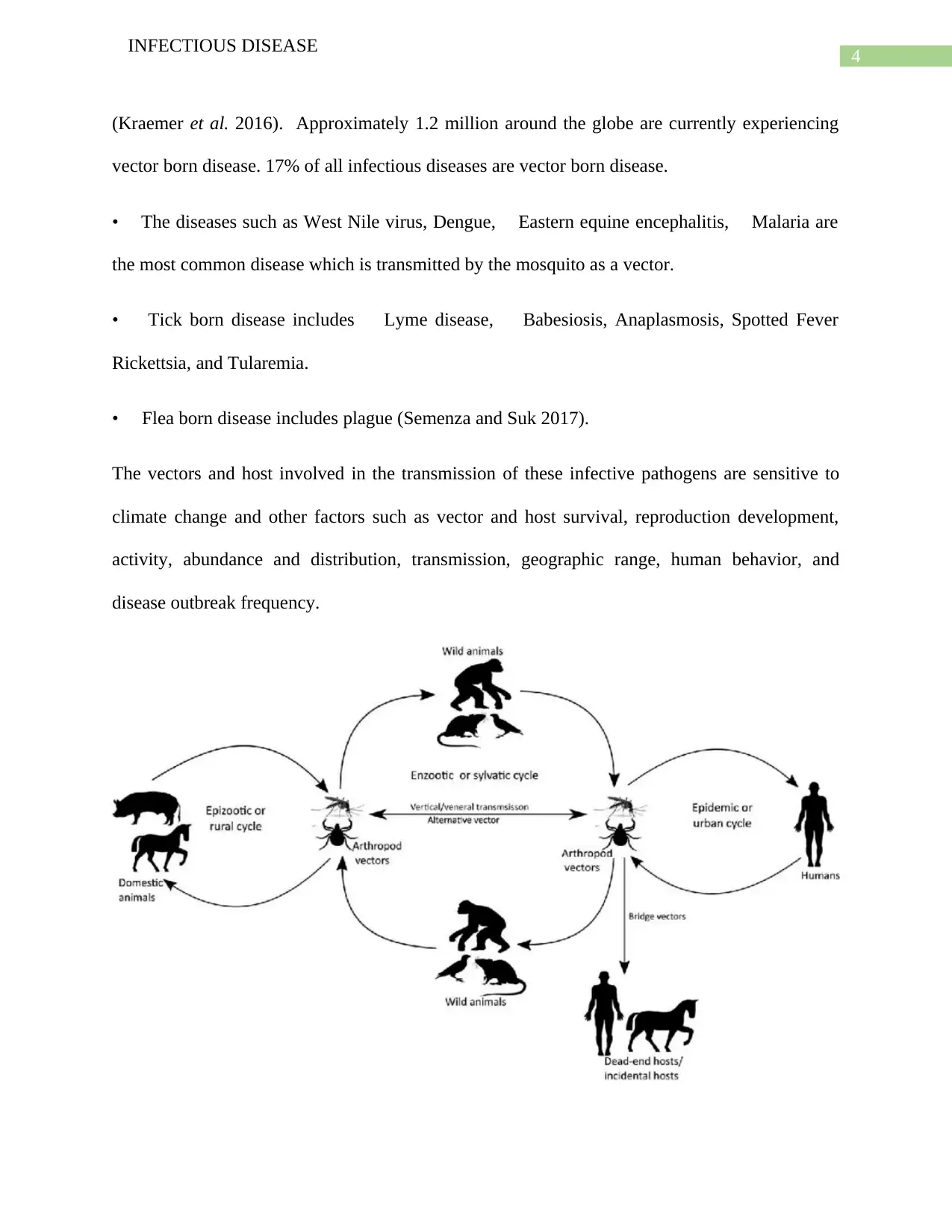
4
INFECTIOUS DISEASE
(Kraemer et al. 2016). Approximately 1.2 million around the globe are currently experiencing
vector born disease. 17% of all infectious diseases are vector born disease.
• The diseases such as West Nile virus, Dengue, Eastern equine encephalitis, Malaria are
the most common disease which is transmitted by the mosquito as a vector.
• Tick born disease includes Lyme disease, Babesiosis, Anaplasmosis, Spotted Fever
Rickettsia, and Tularemia.
• Flea born disease includes plague (Semenza and Suk 2017).
The vectors and host involved in the transmission of these infective pathogens are sensitive to
climate change and other factors such as vector and host survival, reproduction development,
activity, abundance and distribution, transmission, geographic range, human behavior, and
disease outbreak frequency.
INFECTIOUS DISEASE
(Kraemer et al. 2016). Approximately 1.2 million around the globe are currently experiencing
vector born disease. 17% of all infectious diseases are vector born disease.
• The diseases such as West Nile virus, Dengue, Eastern equine encephalitis, Malaria are
the most common disease which is transmitted by the mosquito as a vector.
• Tick born disease includes Lyme disease, Babesiosis, Anaplasmosis, Spotted Fever
Rickettsia, and Tularemia.
• Flea born disease includes plague (Semenza and Suk 2017).
The vectors and host involved in the transmission of these infective pathogens are sensitive to
climate change and other factors such as vector and host survival, reproduction development,
activity, abundance and distribution, transmission, geographic range, human behavior, and
disease outbreak frequency.
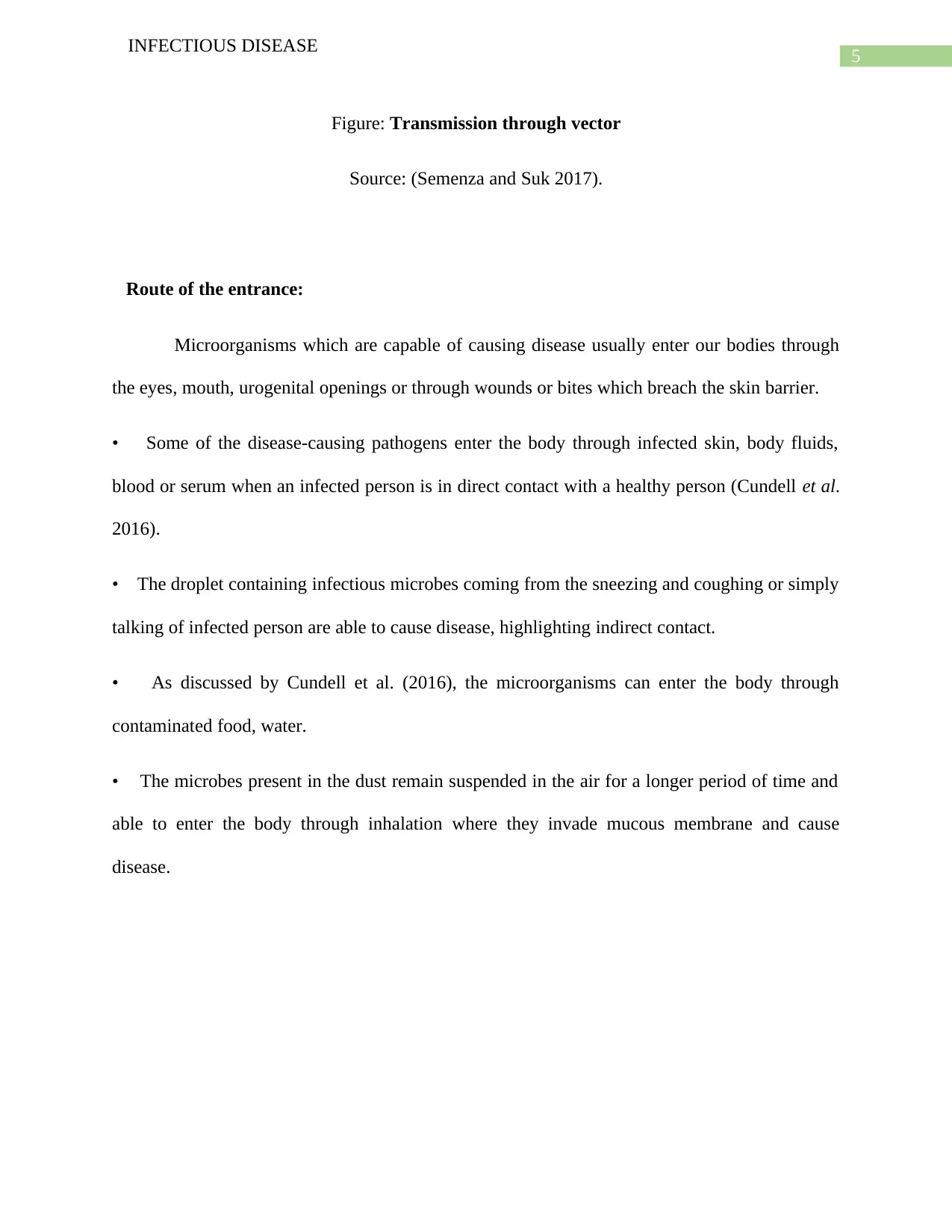
5
INFECTIOUS DISEASE
Figure: Transmission through vector
Source: (Semenza and Suk 2017).
Route of the entrance:
Microorganisms which are capable of causing disease usually enter our bodies through
the eyes, mouth, urogenital openings or through wounds or bites which breach the skin barrier.
• Some of the disease-causing pathogens enter the body through infected skin, body fluids,
blood or serum when an infected person is in direct contact with a healthy person (Cundell et al.
2016).
• The droplet containing infectious microbes coming from the sneezing and coughing or simply
talking of infected person are able to cause disease, highlighting indirect contact.
• As discussed by Cundell et al. (2016), the microorganisms can enter the body through
contaminated food, water.
• The microbes present in the dust remain suspended in the air for a longer period of time and
able to enter the body through inhalation where they invade mucous membrane and cause
disease.
INFECTIOUS DISEASE
Figure: Transmission through vector
Source: (Semenza and Suk 2017).
Route of the entrance:
Microorganisms which are capable of causing disease usually enter our bodies through
the eyes, mouth, urogenital openings or through wounds or bites which breach the skin barrier.
• Some of the disease-causing pathogens enter the body through infected skin, body fluids,
blood or serum when an infected person is in direct contact with a healthy person (Cundell et al.
2016).
• The droplet containing infectious microbes coming from the sneezing and coughing or simply
talking of infected person are able to cause disease, highlighting indirect contact.
• As discussed by Cundell et al. (2016), the microorganisms can enter the body through
contaminated food, water.
• The microbes present in the dust remain suspended in the air for a longer period of time and
able to enter the body through inhalation where they invade mucous membrane and cause
disease.
⊘ This is a preview!⊘
Do you want full access?
Subscribe today to unlock all pages.

Trusted by 1+ million students worldwide
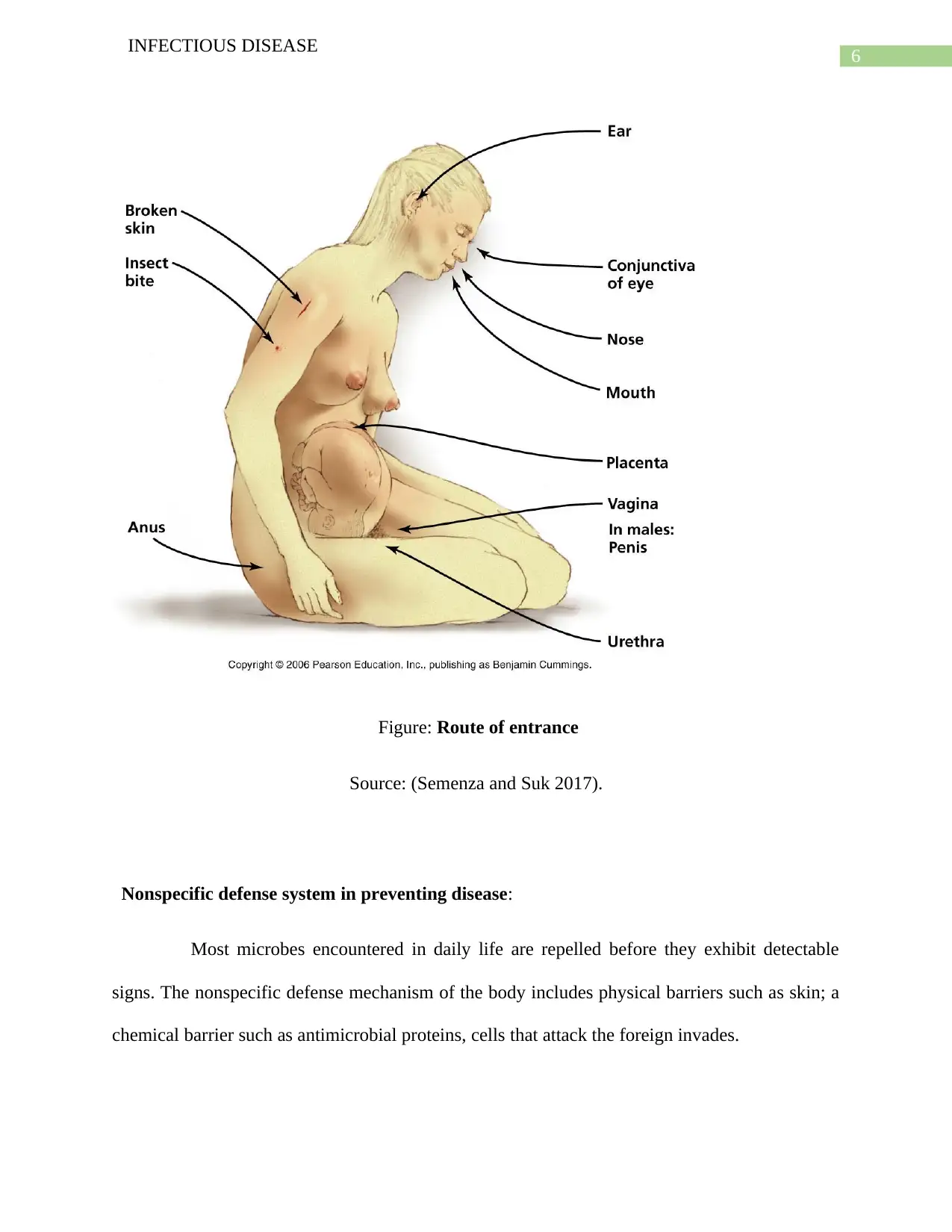
6
INFECTIOUS DISEASE
Figure: Route of entrance
Source: (Semenza and Suk 2017).
Nonspecific defense system in preventing disease:
Most microbes encountered in daily life are repelled before they exhibit detectable
signs. The nonspecific defense mechanism of the body includes physical barriers such as skin; a
chemical barrier such as antimicrobial proteins, cells that attack the foreign invades.
INFECTIOUS DISEASE
Figure: Route of entrance
Source: (Semenza and Suk 2017).
Nonspecific defense system in preventing disease:
Most microbes encountered in daily life are repelled before they exhibit detectable
signs. The nonspecific defense mechanism of the body includes physical barriers such as skin; a
chemical barrier such as antimicrobial proteins, cells that attack the foreign invades.
Paraphrase This Document
Need a fresh take? Get an instant paraphrase of this document with our AI Paraphraser
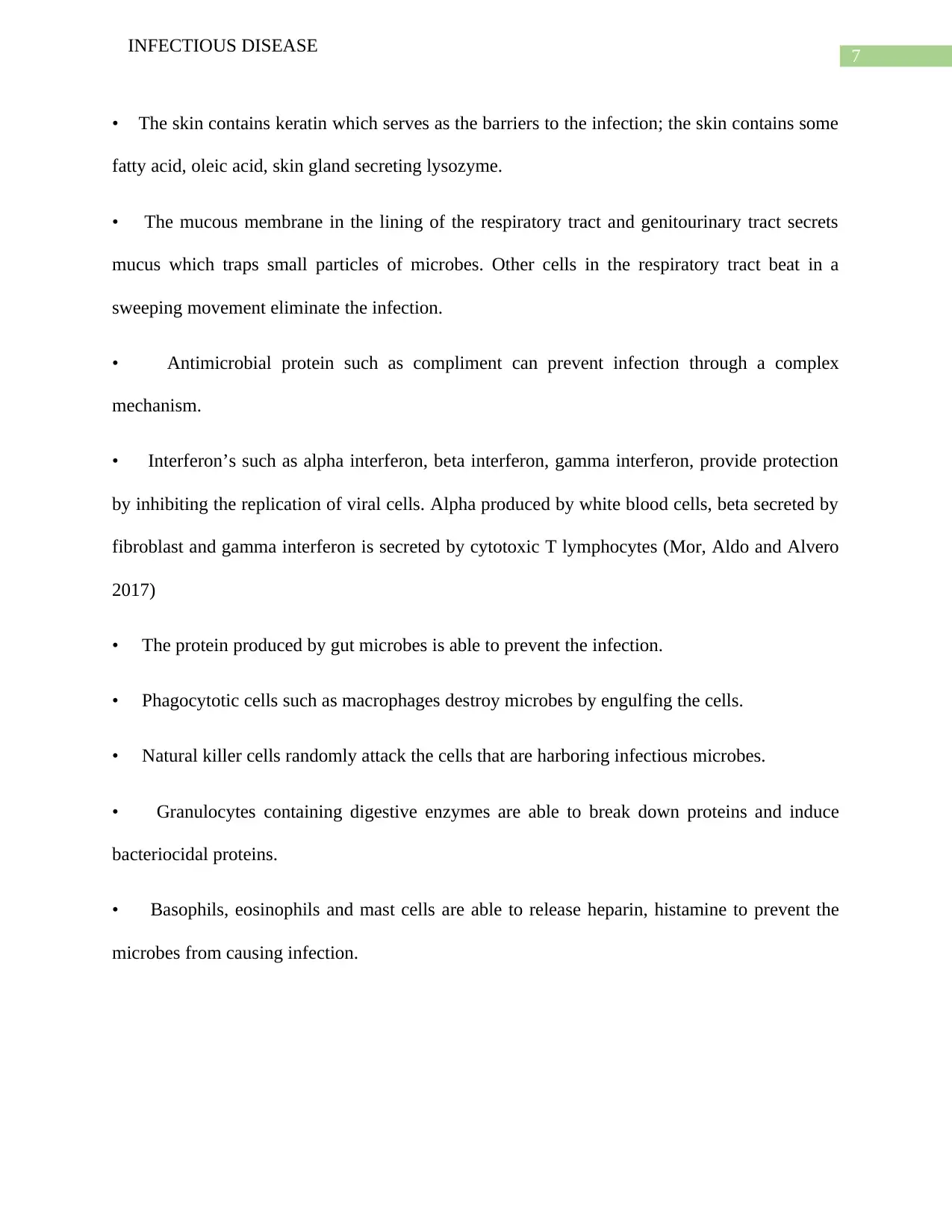
7
INFECTIOUS DISEASE
• The skin contains keratin which serves as the barriers to the infection; the skin contains some
fatty acid, oleic acid, skin gland secreting lysozyme.
• The mucous membrane in the lining of the respiratory tract and genitourinary tract secrets
mucus which traps small particles of microbes. Other cells in the respiratory tract beat in a
sweeping movement eliminate the infection.
• Antimicrobial protein such as compliment can prevent infection through a complex
mechanism.
• Interferon’s such as alpha interferon, beta interferon, gamma interferon, provide protection
by inhibiting the replication of viral cells. Alpha produced by white blood cells, beta secreted by
fibroblast and gamma interferon is secreted by cytotoxic T lymphocytes (Mor, Aldo and Alvero
2017)
• The protein produced by gut microbes is able to prevent the infection.
• Phagocytotic cells such as macrophages destroy microbes by engulfing the cells.
• Natural killer cells randomly attack the cells that are harboring infectious microbes.
• Granulocytes containing digestive enzymes are able to break down proteins and induce
bacteriocidal proteins.
• Basophils, eosinophils and mast cells are able to release heparin, histamine to prevent the
microbes from causing infection.
INFECTIOUS DISEASE
• The skin contains keratin which serves as the barriers to the infection; the skin contains some
fatty acid, oleic acid, skin gland secreting lysozyme.
• The mucous membrane in the lining of the respiratory tract and genitourinary tract secrets
mucus which traps small particles of microbes. Other cells in the respiratory tract beat in a
sweeping movement eliminate the infection.
• Antimicrobial protein such as compliment can prevent infection through a complex
mechanism.
• Interferon’s such as alpha interferon, beta interferon, gamma interferon, provide protection
by inhibiting the replication of viral cells. Alpha produced by white blood cells, beta secreted by
fibroblast and gamma interferon is secreted by cytotoxic T lymphocytes (Mor, Aldo and Alvero
2017)
• The protein produced by gut microbes is able to prevent the infection.
• Phagocytotic cells such as macrophages destroy microbes by engulfing the cells.
• Natural killer cells randomly attack the cells that are harboring infectious microbes.
• Granulocytes containing digestive enzymes are able to break down proteins and induce
bacteriocidal proteins.
• Basophils, eosinophils and mast cells are able to release heparin, histamine to prevent the
microbes from causing infection.
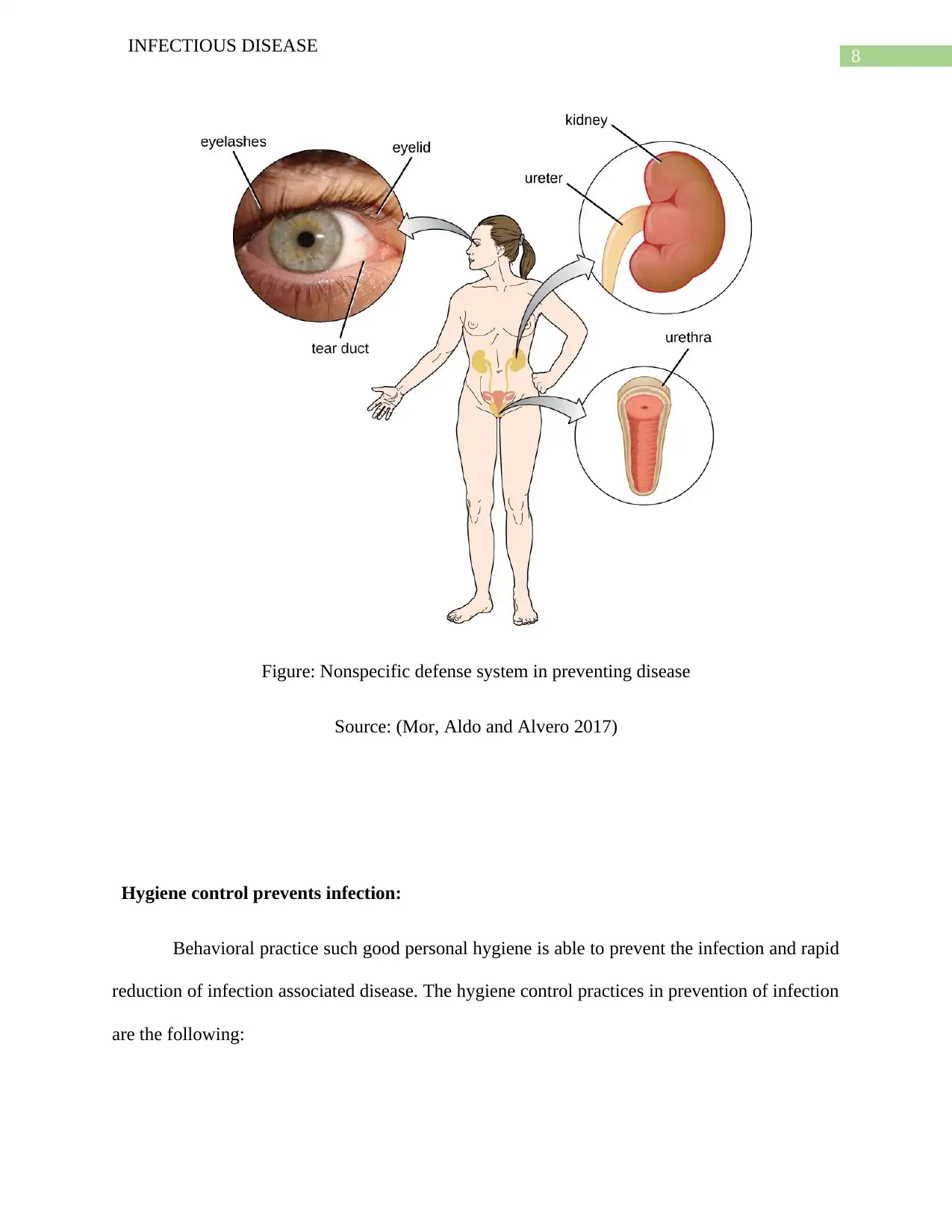
8
INFECTIOUS DISEASE
Figure: Nonspecific defense system in preventing disease
Source: (Mor, Aldo and Alvero 2017)
Hygiene control prevents infection:
Behavioral practice such good personal hygiene is able to prevent the infection and rapid
reduction of infection associated disease. The hygiene control practices in prevention of infection
are the following:
INFECTIOUS DISEASE
Figure: Nonspecific defense system in preventing disease
Source: (Mor, Aldo and Alvero 2017)
Hygiene control prevents infection:
Behavioral practice such good personal hygiene is able to prevent the infection and rapid
reduction of infection associated disease. The hygiene control practices in prevention of infection
are the following:
⊘ This is a preview!⊘
Do you want full access?
Subscribe today to unlock all pages.

Trusted by 1+ million students worldwide
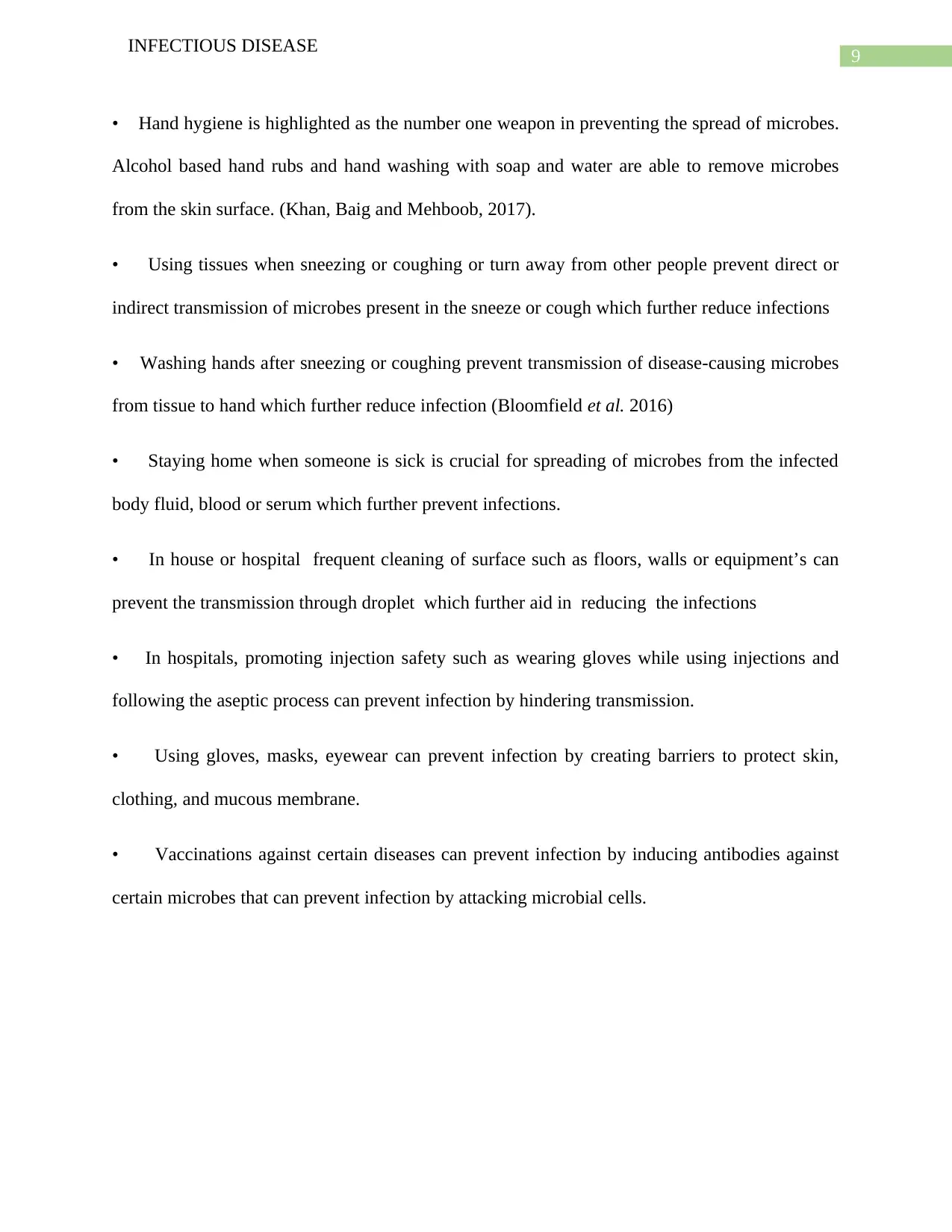
9
INFECTIOUS DISEASE
• Hand hygiene is highlighted as the number one weapon in preventing the spread of microbes.
Alcohol based hand rubs and hand washing with soap and water are able to remove microbes
from the skin surface. (Khan, Baig and Mehboob, 2017).
• Using tissues when sneezing or coughing or turn away from other people prevent direct or
indirect transmission of microbes present in the sneeze or cough which further reduce infections
• Washing hands after sneezing or coughing prevent transmission of disease-causing microbes
from tissue to hand which further reduce infection (Bloomfield et al. 2016)
• Staying home when someone is sick is crucial for spreading of microbes from the infected
body fluid, blood or serum which further prevent infections.
• In house or hospital frequent cleaning of surface such as floors, walls or equipment’s can
prevent the transmission through droplet which further aid in reducing the infections
• In hospitals, promoting injection safety such as wearing gloves while using injections and
following the aseptic process can prevent infection by hindering transmission.
• Using gloves, masks, eyewear can prevent infection by creating barriers to protect skin,
clothing, and mucous membrane.
• Vaccinations against certain diseases can prevent infection by inducing antibodies against
certain microbes that can prevent infection by attacking microbial cells.
INFECTIOUS DISEASE
• Hand hygiene is highlighted as the number one weapon in preventing the spread of microbes.
Alcohol based hand rubs and hand washing with soap and water are able to remove microbes
from the skin surface. (Khan, Baig and Mehboob, 2017).
• Using tissues when sneezing or coughing or turn away from other people prevent direct or
indirect transmission of microbes present in the sneeze or cough which further reduce infections
• Washing hands after sneezing or coughing prevent transmission of disease-causing microbes
from tissue to hand which further reduce infection (Bloomfield et al. 2016)
• Staying home when someone is sick is crucial for spreading of microbes from the infected
body fluid, blood or serum which further prevent infections.
• In house or hospital frequent cleaning of surface such as floors, walls or equipment’s can
prevent the transmission through droplet which further aid in reducing the infections
• In hospitals, promoting injection safety such as wearing gloves while using injections and
following the aseptic process can prevent infection by hindering transmission.
• Using gloves, masks, eyewear can prevent infection by creating barriers to protect skin,
clothing, and mucous membrane.
• Vaccinations against certain diseases can prevent infection by inducing antibodies against
certain microbes that can prevent infection by attacking microbial cells.
Paraphrase This Document
Need a fresh take? Get an instant paraphrase of this document with our AI Paraphraser
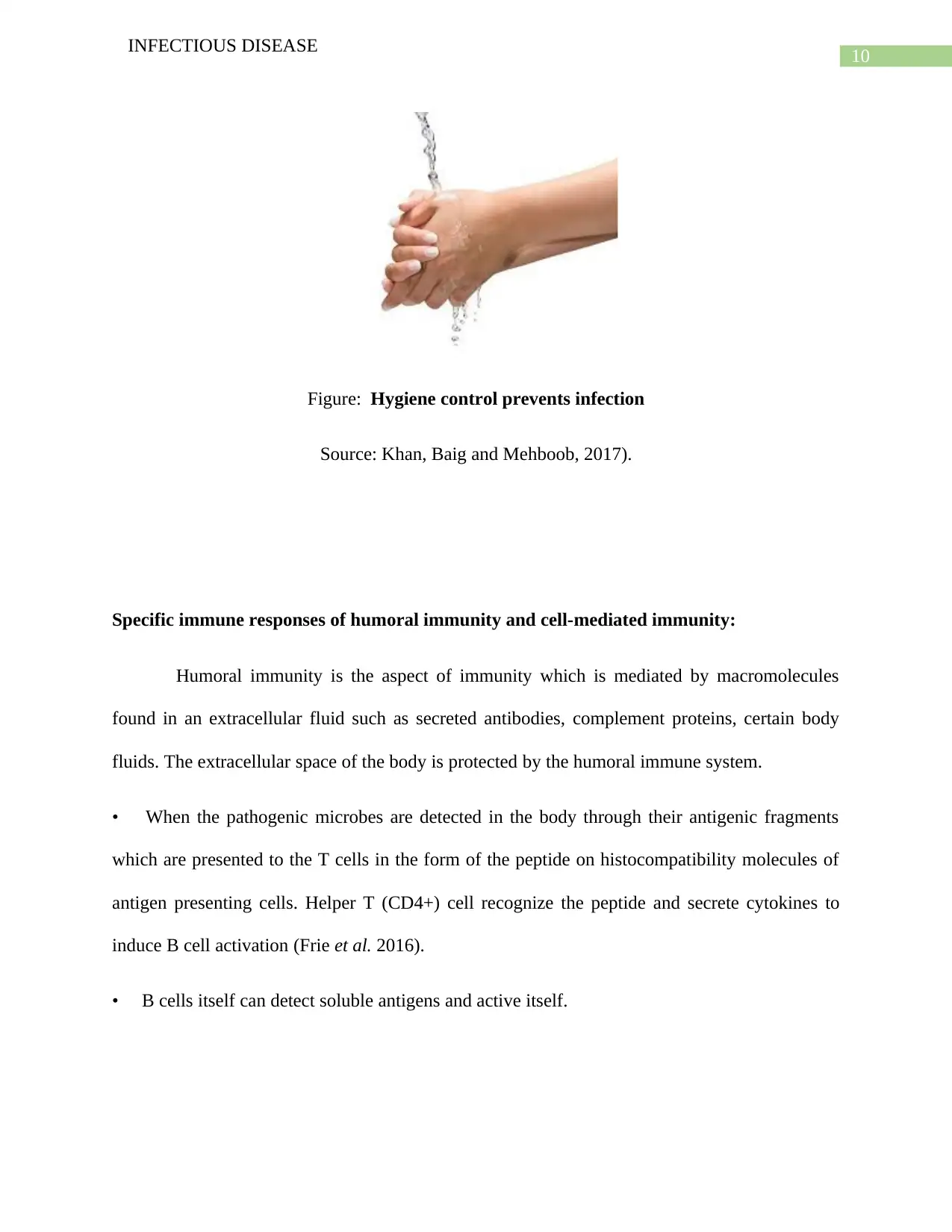
10
INFECTIOUS DISEASE
Figure: Hygiene control prevents infection
Source: Khan, Baig and Mehboob, 2017).
Specific immune responses of humoral immunity and cell-mediated immunity:
Humoral immunity is the aspect of immunity which is mediated by macromolecules
found in an extracellular fluid such as secreted antibodies, complement proteins, certain body
fluids. The extracellular space of the body is protected by the humoral immune system.
• When the pathogenic microbes are detected in the body through their antigenic fragments
which are presented to the T cells in the form of the peptide on histocompatibility molecules of
antigen presenting cells. Helper T (CD4+) cell recognize the peptide and secrete cytokines to
induce B cell activation (Frie et al. 2016).
• B cells itself can detect soluble antigens and active itself.
INFECTIOUS DISEASE
Figure: Hygiene control prevents infection
Source: Khan, Baig and Mehboob, 2017).
Specific immune responses of humoral immunity and cell-mediated immunity:
Humoral immunity is the aspect of immunity which is mediated by macromolecules
found in an extracellular fluid such as secreted antibodies, complement proteins, certain body
fluids. The extracellular space of the body is protected by the humoral immune system.
• When the pathogenic microbes are detected in the body through their antigenic fragments
which are presented to the T cells in the form of the peptide on histocompatibility molecules of
antigen presenting cells. Helper T (CD4+) cell recognize the peptide and secrete cytokines to
induce B cell activation (Frie et al. 2016).
• B cells itself can detect soluble antigens and active itself.
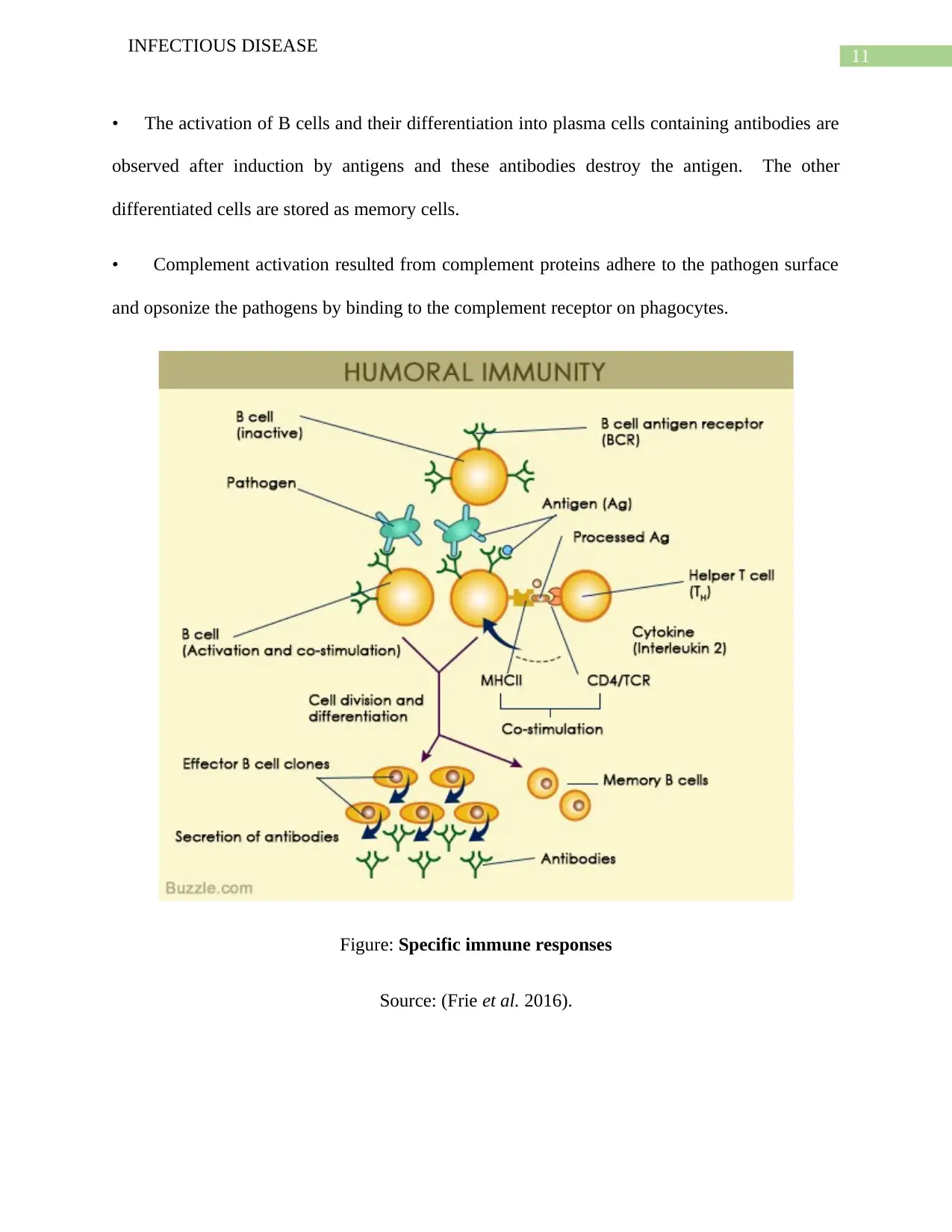
11
INFECTIOUS DISEASE
• The activation of B cells and their differentiation into plasma cells containing antibodies are
observed after induction by antigens and these antibodies destroy the antigen. The other
differentiated cells are stored as memory cells.
• Complement activation resulted from complement proteins adhere to the pathogen surface
and opsonize the pathogens by binding to the complement receptor on phagocytes.
Figure: Specific immune responses
Source: (Frie et al. 2016).
INFECTIOUS DISEASE
• The activation of B cells and their differentiation into plasma cells containing antibodies are
observed after induction by antigens and these antibodies destroy the antigen. The other
differentiated cells are stored as memory cells.
• Complement activation resulted from complement proteins adhere to the pathogen surface
and opsonize the pathogens by binding to the complement receptor on phagocytes.
Figure: Specific immune responses
Source: (Frie et al. 2016).
⊘ This is a preview!⊘
Do you want full access?
Subscribe today to unlock all pages.

Trusted by 1+ million students worldwide
1 out of 19
Related Documents
Your All-in-One AI-Powered Toolkit for Academic Success.
+13062052269
info@desklib.com
Available 24*7 on WhatsApp / Email
![[object Object]](/_next/static/media/star-bottom.7253800d.svg)
Unlock your academic potential
Copyright © 2020–2025 A2Z Services. All Rights Reserved. Developed and managed by ZUCOL.





